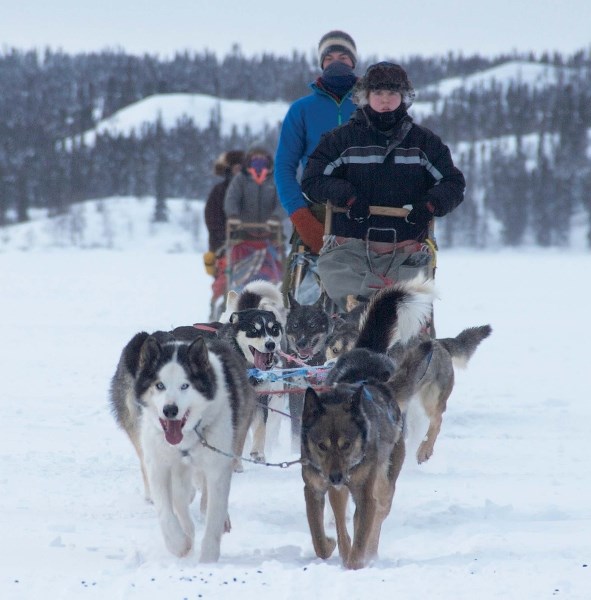Imagine traveling up to Great Slave Lake in the Northwest Territories, dog-sledding across Canada's untouched north with not a worry in mind. Just you, some friends and the Great White North.
That is exactly what Bonnyville's Laura Dokter experienced in February, with her Augustana campus classmates.
Dotker, who is enrolled in the Environmental Sciences program at the University of Alberta's Augustana campus in Camrose, was provided with the opportunity to take this trip, which ran from February 13 to March 3, and included Dokter, a professor and 11 other students exploring Canada's north.
The group drove from Camrose to Peace River, then on to Yellowknife. From there they chartered a small plane to the east arm of Great Slave Lake, but not before some sightseeing in Yellowknife.
“We thought, lets go see Buffalo Airways from the show Ice Pilots, just to look through the fence,” said Dokter “When we got there Buffalo Joe was actually there, he invited us in and took us on a tour through his whole hanger. It was really neat.”
After that, the class met up with Dave Olesen, the owner of Hoarfrost River Huskies Ltd., a northern business that specializes in air charters and dogsled expeditions. He flew into Yellowknife, picked the group up and brought them to his “homestead.”
“We saw lots of muskox and caribou on the flight up,” said Dokter. “The pilot was banking the plane. It was really neat to see.”
The first week up there the group took a dog sledding expedition lead by Olesen.
“We got up early, ate breakfast, made a fire and did all of our chores. Dave would feed the dogs. We would load up all of the sleds and go for the whole day,” said Dokter, describing a normal day on the expedition. “We would go until about 5 p.m., then stop and make camp for the night.”
The group slept in a 12-by-12 arctic oven extreme tent, which was equipped with a small stove.
“We would basically cook over a fire or a two-burner stove,” said Dokter. “We had stew, pasta and other things that were easy to make, things you could throw into a pot and thaw out. You basically had to plan on everything freezing.”
According to Olesen, the group set a record on their trip, when they experienced minus 50 degree Celsius weather (not including wind chill) on the final day.
“When you breathe at minus-50 degrees you can hear your breath crackling. It was crazy,” said Dokter.
“But we had dressed for the cold. Just wore layers and layers and layers,” she explained. “Basically I went and raided my parents closet before the trip, because you need big huge layers.”
Having the ability to hear her breath crackle was aided by the fact she and the rest of her classmates where in the middle of nowhere.
“There was nobody around. There are no roads up there. There is nothing,” said Dokter.
The team used double dogsleds with eight to ten dogs per sled to travel the trail north.
Dokter said she really got to know the dogs who drove her sled. Bone, Wilson, Cheeno, Mr. Thor, Minsk, Minosa, Miracle Max, Xtryder, Blueprint and Willow were the dogs she spent the trip with.
With double sleds you have the dogs up front tied to one sled, and then a second sled tied to the first one.
Sledding up north in the middle of nowhere with a group of first time dogsledders doesn't come without its challenges.
“When we first went out we had crappy rope between the two sleds and it kept breaking. Whenever we went over a tree or a bush the sleds would break apart,” said Dokter. “There were runaway sleds. All of a sudden you would see a dogsled just going down the trail with nobody on it.”
Dokter, a first time dogsledder, also managed to get run over by another sled.
“I was on the front sled and a whole bunch of events happened and I got run over,” said Dokter, laughing about the incident. “The guy on the back ended up falling off and I had to wait for him. He got on the sled on his knees and he ran me over. We were all just sitting in the snow killing ourselves laughing.”
The second week of their trip saw them spend time around the homestead, ice fishing and hunting.
According to Dokter the group wasn't too successful at hunting.
“We walked for three hours one day trying to find something to shoot. The scenery was gorgeous, but we couldn't find anything,” said Dokter. “The next day on my way to the water hole, I saw two ptarmigan not even five feet from me.”
Week two was spent more on writing and class work, as the University students still had some assignments to complete.
“We would get up, have breakfast, do our chores, have an hour of journal writing time, then a two hour seminar,” said Dokter, describing a normal day at the homestead. “At the end of the trip we had to write a personal narrative. That was the big cumulative project.”
Dokter said they were spoiled on the last night at the homestead and treated to caribou and muskox stew.
“They asked us when we came back to pick a highlight of the trip and I can't. We did so much, I couldn't pick one thing,” said Dokter, who is planning to go on a canoe trip on Great Slave Lake with some friends this summer.



